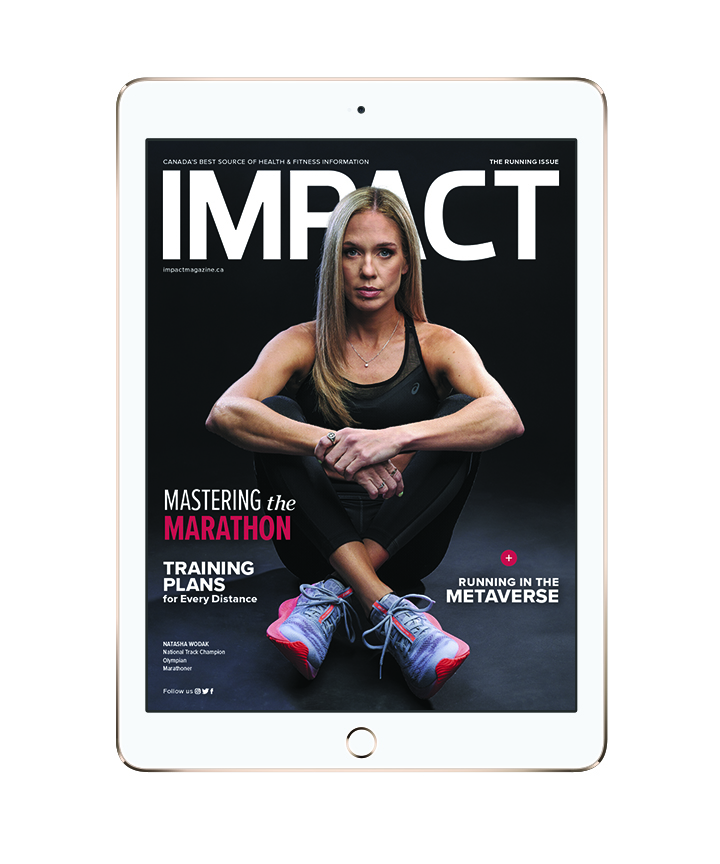
Runners seeking a magic bullet to prevent injuries will have to keep searching.
A study published in the Journal of Athletic Training in September 2021 sought correlations between running-related injuries and training parameters—such as distance, duration, frequency, intensity—and changes to training regimens.
To the disappointment of runners everywhere, the research provided no eureka moments.
The study was led by Jean-Francois Esculier, a medical professor at the University of British Columbia and leader of research and development at The Running Clinic, based north of Québec City. The team examined 36 studies featuring 23,000 adult runners.
Results were underwhelming, if not unexpected: there is no clear connection between injuries and training circumstances.
None of the professionals we spoke with were surprised.
Rob Hasegawa, a chiropractor at Good to Go Sports Therapy in Victoria, B.C., specializes in running injuries and has worked with athletes of all levels.
“The more years I’ve been in practice, one of the most common things I do when someone asks me what I think they did (to get injured) is shrug my shoulders,” he says. “There’s just so many variables… It can be anything on any given day.”
Calgary’s Cal Zaryski, owner of CriticalSpeed.com, agrees, saying “We can’t hang our hats on one or two metrics (like heart rate). It’s just a mathematical model. The reality is the human body is way more complex than that.”
Zaryski is a high-performance athlete as well as a coach. In 2021, he won both the Ironman 70.3 World Championship and the XTERRA off-road triathlon—his tenth in the latter—for his age group.
Sometimes, the cause of an injury is obvious, he explains, remembering a sore ankle he developed after running barefoot on sloping sand in Maui. Other times, issues “come out of the blue,” he says. “A little ache or pain, or some issue that’s starting to brew. It accumulates. It’s just too complex to figure out the cause of certain things. The key is to catch them before they become an injury.”
The clear message from the study, Zaryski says, is that training prescriptions need to be dynamic, to adapt to each individual’s situation any given day.
One way to ensure dynamism in training is to work with a coach.
Bruce Deacon, two-time Olympic marathoner and running coach in Victoria says having a good coach can help avoid injuries, but there’s a caveat: the runner needs to provide the coach with enough information and feedback to make critical training decisions.
“The value of your money, of your investment (in coaching), is only enhanced when you’re open, honest and trusting with your coach. Let your coach know, ‘I didn’t sleep well, I feel a little niggle in the back of my throat,’” he says, noting that coaches need to know about mood and mental and emotional stress, too. “A coach needs all the information to keep you healthy.”
Ultimately, the takeaway from Esculier’s study is that runners need personalized care to be at their best. Every runner
is unique, so unique that the variables that lead to running-related injuries are too broad and too complex to reveal straightforward causes and effects.
So how do we continue to train—to challenge our bodies to get stronger, faster, and more resilient—while also avoiding injury?
“We all want to know how much change we can introduce (without causing injury),” Deacon says. “I agree with the (study’s) premise that the more you change, and the more quickly you change it, the more likely you are going to get hurt.”
“(Avoiding injury) becomes more art than science,” he adds.
For Hasegawa, who sees thousands of injuries in his practice, the responsibility for keeping healthy lies with the athlete.
“No one knows you better than yourself. We have to let go of our ego and be really mindful,” he says. “You have to take responsibility for this. Not your coach, not me. You have to wear this yourself.”
Hagesawa adds: “If we could be more mindful all around to all the different things that are happening in our lives, I think we’d be better off.”
Could mindfulness be the key to avoiding running injuries? Perhaps the magic bullet has been within us all this time.
4 TIPS TO MITIGATE INJURIES
1 SELF-AWARENESS FOR SELF-PRESERVATION
If you’re mindful of how you’re feeling, mentally and physically—and, if you’re honest with yourself—you’ll be more likely to catch issues before they develop into injuries.
“We have to let go of our ego,” says Rob Hasegawa, chiropractor at Good to Go Sports Therapy. “Running as a group is social, but it creates injuries because people don’t listen to their body. They want to stay with the group until they can’t, unfortunately, until they get injured.”
With self-awareness and maturity, you’ll come to recognize your limits and know when to push and when to rest.
“No one knows you better than yourself,” Hasegawa says.
2 CHANGING FOR GOOD
Whenever you change something in your workout—your shoes, the running surface, the distance—you’re increasing the potential of injury as your body adapts. Change your training routine thoughtfully and carefully to avoid stress that may lead to injury.
On the other hand, change may also be part of the solution. “There’s always going to be changes to your [training] program because of a little ache or pain, or some issue that’s starting to brew or accumulate,” athlete and coach Cal Zaryski says. “The message here is you have to make it so things can change consistently, never be locked in.”
3 REST, RECOVERY, REBUILD
Rest can work in your favour. “If we give our body enough rest, we actually get stronger,” running coach Bruce Deacon says. “In an unrecovered state, all kinds of vulnerabilities come up.”
Runners might become more vulnerable to twisting their ankles, or muscle soreness could lead to a change in form resulting in injury. The amount of rest needed depends on the individual and their goals.
4 CARE TEAM
Assemble a team of coaches and health-care professionals to help look after you and keep you well. Work with people you trust to care for your health, both physical and mental.
“Your moods affect your physiology, and therefore, they affect your vulnerability to injury and sickness,” Deacon says. “Happy runners are healthy.”
Photography by Graham McKerrell

Read This Story in Our 2022 Running Digital Edition
2022 RACE SOURCE GUIDE. Training plans for every distance, yoga for runners, athletes with impact, running in the metaverse, recipes and much more!
















